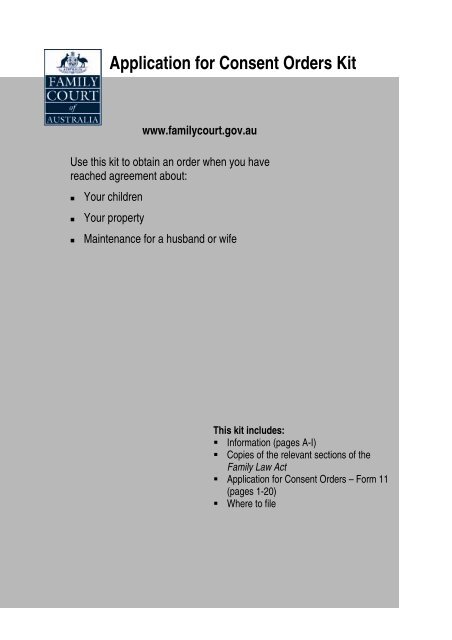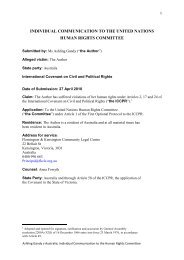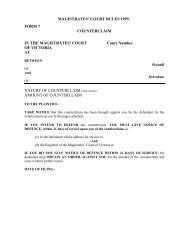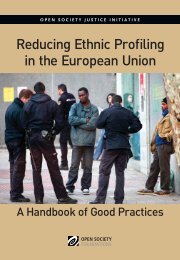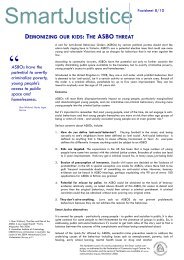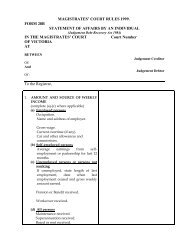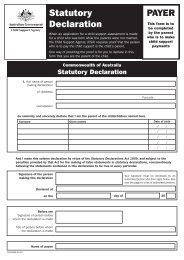Application for Consent Orders Kit - Community Law
Application for Consent Orders Kit - Community Law
Application for Consent Orders Kit - Community Law
Create successful ePaper yourself
Turn your PDF publications into a flip-book with our unique Google optimized e-Paper software.
<strong>Application</strong> <strong>for</strong> <strong>Consent</strong> <strong>Orders</strong> <strong>Kit</strong>www.familycourt.gov.auwww.familycourt.gov.auUse this kit to obtain an order when you havereached agreement about:! Your childrenUse this kit when asking <strong>for</strong> Court orders to end a marriage! Your property! Maintenance <strong>for</strong> a husband or wifeThis kit includes:# In<strong>for</strong>mation (pages A-I)# Copies of the relevant sections of theFamily <strong>Law</strong> Act# <strong>Application</strong> <strong>for</strong> <strong>Consent</strong> <strong>Orders</strong> – Form 11(pages 1-20)# Where to fileCHECKLIST
CHECKLISTThis checklist is provided as a guide to completing the <strong>for</strong>m correctly. It highlights particularquestions which the Court has found people do not always answer correctly or fully.At Part A, Item 3 on page 1, have you clearly stated your contact address (address <strong>for</strong> service)in Australia?At Part B on page 2, have you given details of your relationship? If you were married you willneed to provide the Court with a photocopy of your Marriage Certificate or Certificate of Divorcewhen you lodge the application.At Part C, Item 13 & 14 on pages 3 & 4, have you provided details of any ongoing Court casesor existing orders concerning the husband, wife or the children? Where there is an existing orderyou may either attach a copy of the order or set out the details of that order. If the orders youseek are intended to vary or discharge an existing order made in a registry other than the registryin which the <strong>Application</strong> <strong>for</strong> <strong>Consent</strong> <strong>Orders</strong> is to be filed, then sealed copies of the existing ordermust be filed.At Part C, Item 21 on page 5, if there is a proceeds of crime order or a <strong>for</strong>feiture application inexistence in relation to any of the property of any of the parties, have you attached a sealedcopy of the order or application?At Part E on page 6, have you attached the signed draft <strong>Consent</strong> <strong>Orders</strong> to the application<strong>for</strong>m?At Part F on pages 7-8, if you are seeking parenting orders, have you provided separatein<strong>for</strong>mation <strong>for</strong> each child?At Part G on pages 9-12, if you are the applicant and you are seeking property or maintenanceorders, have you completed column 1 and has the respondent completed column 2?At Part G, Item 47 on page 13, if you are the applicant and you are seeking property ormaintenance orders have you provided your total net worth (not including superannuation) bysubtracting your liabilities from the total value of property owned by you, and has the respondentdone the same?At Part G, Item 48 on page 13, if you are seeking property or maintenance orders and eitherparty has acquired or disposed of any property since the date of separation have the details beenprovided?At Part G, Items 49-53 on page 14, if a superannuation splitting order is sought, have you giventhe details required and attached a completed superannuation in<strong>for</strong>mation <strong>for</strong>m? If you havemore than one superannuation interest have you attached a list of all your superannuationinterests and given the details required <strong>for</strong> each interest?At Part H on pages 17 & 18, if you are seeking property orders have you addressed each itemand provided the net value of the property that the applicant and the respondent will eachreceive? If you are seeking an order in relation to superannuation have you provided the grossvalue of the superannuation that the applicant and the respondent will each receive and have youset out the taxation consequences of the order sought?At Part I & Park K on pages 18 & 19, have you marked every box that applies to you? Have yousworn/affirmed and signed your affidavit in the presence of a Justice of the Peace, notary publicor lawyer?At Part J & Part L on pages 19 & 20, if you have sought independent legal advice about theorders you seek has the lawyer completed and signed the statement of independent legaladvice?If you are not married and you are seeking an order about children have you filed a copy of thebirth certificate of each child with your <strong>Application</strong> <strong>for</strong> <strong>Consent</strong> orders?Have you made two photocopies of the completed application <strong>for</strong> <strong>Consent</strong> <strong>Orders</strong> (Form 11) andtwo photocopies of the signed draft <strong>Consent</strong> <strong>Orders</strong>? These will need to be presented when youfile the original <strong>Consent</strong> Order <strong>for</strong>m with the attached draft <strong>Consent</strong> <strong>Orders</strong>.Have you answered every question that applies to you?Ensure that you file the application within 90 days of the date of first affidavit (see Parts I and K).
About this kitThis kit can be used to apply <strong>for</strong> <strong>Consent</strong> <strong>Orders</strong> about the care, welfare and development of yourchildren (known as parenting orders), the division of property or maintenance <strong>for</strong> a husband or wife or<strong>for</strong>mer husband or wife (known as spouse maintenance). It can also be used if you are applying <strong>for</strong><strong>Consent</strong> <strong>Orders</strong> which vary or discharge existing Family Court orders.AImportant noteYou should read this kit carefully.You are responsible <strong>for</strong> making sure all your paperwork is in order. Family Court staff can help you withthe provision of <strong>for</strong>ms and in<strong>for</strong>mation about the processing of your application but they cannot give youlegal advice.If you do not comply with the Family <strong>Law</strong> Act and Family <strong>Law</strong> Rules, your application <strong>for</strong> <strong>Consent</strong> <strong>Orders</strong>may be delayed or refused.If the parenting orders you intend to seek are inconsistent with a family violence order between anyof the parties or concerning any of your children then your application must be heard in court. In thiscase you may need to consider submitting a different type of application. You should seek legal advicebe<strong>for</strong>e proceeding any further.About the words used in this <strong>Kit</strong>Affidavit - is a written statement which is sworn oraffirmed by you be<strong>for</strong>e a Justice of the Peace, notarypublic or lawyer. You must have the affidavit at PartsI & K of the <strong>Application</strong> <strong>for</strong> <strong>Consent</strong> <strong>Orders</strong> sworn oraffirmed be<strong>for</strong>e filing it with the Court.Applicant – The person who seeks to have theCourt make orders.Contact address (address <strong>for</strong> service) inAustralia - the address in Australia that a party in acase nominates as being the place wheredocuments are to be left <strong>for</strong> them or mailed, faxed oremailed to them.Family violence order – an order made under aprescribed law of a State or Territory to protect aperson from family violence. Family violence meansconduct, whether actual or threatened, by a persontowards, or towards the property of, a member of theperson’s family that causes that or any othermember of the person’s family to fear <strong>for</strong>, or to beapprehensive about, his or her personal well beingor safety. (See the Family <strong>Law</strong> Act, Section 60D)Electronic communication – as the contextpermits includes transmission of in<strong>for</strong>mation in the<strong>for</strong>m of speech, data, text or images <strong>for</strong> example bytelephone, or videoconferencing, closed circuittelevision, facsimile or email.Draft <strong>Consent</strong> <strong>Orders</strong> – a term used to describethe signed agreement which you wish to have madeinto court orders.Filing - the procedure of you lodging an applicationor other document with a registry of the Court. Youcan do this by hand, post or electronic means.Maintenance – financial supportMedical procedures – an <strong>Application</strong> <strong>for</strong> Final<strong>Orders</strong> (Form 1) seeking an order authorising amajor medical procedure on a child which is not<strong>for</strong> the purpose of treating some malfunction ordisease.Party - a person involved in a case be<strong>for</strong>e theCourt. Once the <strong>Application</strong> <strong>for</strong> <strong>Consent</strong> <strong>Orders</strong> isfiled, both the applicant and respondent becomeparties to the application.Registrar – the person who considersapplications <strong>for</strong> <strong>Consent</strong> <strong>Orders</strong>Registry - how Family Court offices are known,<strong>for</strong> example, the Melbourne Registry is in theCommonwealth <strong>Law</strong> Courts building on WilliamStreet.Respondent – Party to an application <strong>for</strong><strong>Consent</strong> <strong>Orders</strong> who is asked to consent to anapplication to have the Court make the orders.Sealed copy – a copy of a document which hasan original Court seal stamped on it.Service - the process of giving or deliveringdocuments to a party after the documents havebeen filed. You should obtain the Court Service<strong>Kit</strong>.Spouse – a husband or wife, or <strong>for</strong>mer husbandor wife.Spouse maintenance – financial support <strong>for</strong> ahusband or wife, or <strong>for</strong>mer husband or wife asthe case may be.Superannuation In<strong>for</strong>mation Form – a <strong>for</strong>mrequired to be used in property cases wherethere are superannuation interests beingconsidered as part of the property settlement ordivision. The <strong>for</strong>m is used to seek in<strong>for</strong>mationfrom the trustee of the superannuation plan.
BWhat are consent orders?The Family Court encourages families in dispute to reach agreement about the care, welfare anddevelopment of their children, the division of property or spouse maintenance.If you want your agreement to become an order of the Court, you can apply <strong>for</strong> ‘<strong>Consent</strong> <strong>Orders</strong>’ to bemade without having to actually go to Court. You can do this by using this kit or with the help of yourlawyer.<strong>Consent</strong> <strong>Orders</strong> have the same legal effect as an order made after a Court hearing.The <strong>Consent</strong> <strong>Orders</strong> you cannot seek by using thisapplication# Child maintenance <strong>for</strong> children covered by the Child Support (Assessment) Act, that is, those under18 who were born after 1 October 1989 or whose parents separated after that date – this ishandled by the Child Support Agency which can be contacted on tel 131 272 <strong>for</strong> the cost of a localcall.# Property between couples who have not been married (except in Western Australia).# Medical procedures.# <strong>Orders</strong> under cross vesting laws.# Step parent maintenance, that is, where the parties are a parent and step parent of the child (seeRule 4.16).# A parenting order in favour of a person who is not a parent under Section 65G of the Family <strong>Law</strong>Act.You should seek legal advice be<strong>for</strong>e proceeding any further with any of these types of applications.What you need to considerIt is important that you understand the meaning and effect of the orders you are seeking.Even if you have decided to make your application without the help of a lawyer, you should obtainindependent legal advice about the effect and consequences of the order you propose.If you are seeking orders concerning children you should read and consider sections 60B, 65E and 68Fof the Family <strong>Law</strong> Act.If you are seeking property orders, you should read and consider sections 75 and 79 and Part VIIIB ofthe Family <strong>Law</strong> Act.If you are seeking spouse maintenance orders, you should read and consider sections 72, 74 and 75 ofthe Family <strong>Law</strong> Act.All of these sections, except <strong>for</strong> Part VIIIB (which deals with superannuation interests), are set out onthe following pages. Part VIIIB can be accessed through the Family Court website:www.familycourt.gov.auWhat the Court must considerThe matters the Court must consider when deciding an <strong>Application</strong> <strong>for</strong> <strong>Consent</strong> <strong>Orders</strong> are set out inthe Family <strong>Law</strong> Act. The Court has to be satisfied that:# <strong>for</strong> parenting orders, the arrangements are proper;# <strong>for</strong> property orders, the arrangements are just and equitable.If the Court is satisfied that the orders should be made, the Court will issue the <strong>Consent</strong> <strong>Orders</strong>. Copieswill be returned to you.
CSetting out your ordersThe orders you seek concerning your children, property or spouse maintenance will depend on thecircumstances of your family.You should seek legal advice about what orders to apply <strong>for</strong>.Generally, <strong>Consent</strong> <strong>Orders</strong> that can be made by a court fall into two categories – parenting orders andfinancial orders.PARENTING ORDERSThese include orders relating to:! Residence – with whom the child lives, including any shared arrangements.! Contact – the times that a child may be with a parent with whom they are not living, or anyone elsewho plays an important part in their life, such as a grandparent. Contact can be either face-to-face,or by phone, email or letters.! Child maintenance – <strong>for</strong> children not covered by the Child Support (Assessment) Act. If you areunsure contact the Child Support Agency.! Specific issues – any other aspect of parental responsibility. This may include the day-to-daycare, welfare and development of a child, religion, education and sport.FINANCIAL ORDERSThese include orders relating to:! Spouse maintenance – financial support <strong>for</strong> a husband or wife or <strong>for</strong>mer husband or wife! Property – how your property, superannuation, financial resources and liabilities should be sharedbetween you.Once you have reached agreement you need to prepare your application to the Court. See the ‘How toapply’ section on page 1 of this <strong>Kit</strong>.Following are parts of the Family <strong>Law</strong> Act 1975, which you should read be<strong>for</strong>e applying <strong>for</strong> <strong>Consent</strong><strong>Orders</strong>.SUPERANNUATIONThere are special requirements where you are making an application <strong>for</strong> orders <strong>for</strong> property settlementand either party has a superannuation interest.If you are seeking a splitting order in relation to a superannuation interest in accordance with Section90MT of the Family <strong>Law</strong> Act:(a) You must attach to the application a completed Superannuation In<strong>for</strong>mation Form in relation to thatsuperannuation interest.(b) You must calculate and agree the value of the superannuation interest and consider the taxationconsequences of the order. If the Family <strong>Law</strong> (Superannuation) Regulations 2001 provide amethod <strong>for</strong> calculating the value then the method must be used. Otherwise you must agree anappropriate method of valuing the interest. The completed Superannuation In<strong>for</strong>mation Form willhave sufficient in<strong>for</strong>mation to allow the value to be calculated in accordance with the regulations.(c) Where a base amount is allocated then that amount cannot exceed the value of the interest (seeSection 90MT(4)).If you are seeking an order that imposes an obligation on the Trustee of the superannuation plan youmust satisfy the court that the Trustee has been accorded procedural fairness in relation to the makingof the order.The court requires that at least 28 days be<strong>for</strong>e filing the application , you must serve the followingdocuments on the Trustee of the superannuation plan in which the superannuation interest is held:(a) a copy of the draft consent order that you intend to apply <strong>for</strong>, signed by the parties;(b) a written notice stating that:(i)the parties intend to apply <strong>for</strong> the order sought if no objection to the order is received from theTrustee within 28 days after receiving the notice; and(ii) if the Trustee objects to the order sought, the Trustee must give the parties written notice of theobjection within the same period of 28 days.If the Trustee does not object to the orders sought within 28 days after receiving the notice you may filethe application.The draft <strong>Consent</strong> <strong>Orders</strong> must contain a provision that each party and the Trustee have liberty toapply in relation to the implementation of the orders affecting the superannuation interest.You should seek legal advice, and where necessary accounting advice about these requirements.
DWhat if there is an existing order?If the orders you seek are intended to vary or discharge an existing order which was made in any otherCourt or Family Court registry, other than the registry in which the <strong>Application</strong> <strong>for</strong> <strong>Consent</strong> <strong>Orders</strong> is tobe filed, then sealed copies of the existing order must also be filed.Other documentsIf there has been no other case involving you at the Family Court registry in which your <strong>Application</strong> <strong>for</strong><strong>Consent</strong> <strong>Orders</strong> is to be filed you must also file a copy of the following:! Marriage certificate (see below) or Certificate of Divorce! Birth certificate of each child (if you were not married and you are seeking an order about children)Marriage certificateIf you were married, you must file a photocopy of your Marriage Certificate. If you do not have yourmarriage certificate to photocopy a certified copy can be obtained from the Registrar of Births, Deathsand Marriages in the country, state or territory where you were married.If you cannot provide a photocopy of your marriage certificate, then the Court will need evidence fromyou in an affidavit proving that you are married. You should obtain legal advice about how to do this.If your marriage certificate is not in English, then you must also lodge:! an English translation of it, and! an affidavit from the translator which~ states his or her qualifications to translate,~ attaches a copy of the marriage certificate,~ attaches the translation,~ states that the translation is an accurate translation of the marriage certificate, and~ states that the attached copy of the marriage certificate is a true copy of the marriage certificatetranslated.If you have been divorced you may file a copy of the Certificate of Divorce or decree.Change of name, addressIf you change address after the application is filed you must file a Notice of Address <strong>for</strong> Service (Form8) so the Court can send any papers to the correct address. This <strong>for</strong>m is available from the FamilyCourt website: www.familycourt.gov.au or Court registries. If you change your name after theapplication has been filed, you must in<strong>for</strong>m the Court in writing.Duty of disclosureYou must make full disclosure of your financial circumstances. You must read Rule 13.04 of the Family<strong>Law</strong> Rules.WARNINGA failure to give full and frank disclosure has serious consequences. These consequences mayinclude:! any consent orders being set aside;! you having to pay the other party’s legal costs;! your being fined;! you being charged with contempt of court.
EParenting ordersSECTION 60B OBJECT OF PART AND PRINCIPLES UNDERLYING IT60B(1) [Object of Part] The object of this Part is to ensure that children receive adequate and properparenting to help them achieve their full potential, and to ensure that parents fulfil their duties, and meettheir responsibilities, concerning the care, welfare and development of their children.60B(2) [Principles underlying object] The principles underlying these objects are that, except when itis or would be contrary to a child’s best interests:(a) children have the right to know and be cared <strong>for</strong> by both their parents, regardless of whether theirparents are married, separated, have never married or have never lived together; and(b) children have a right of contact, on a regular basis, with both their parents and with other peoplesignificant to their care, welfare and development; and(c) parents share duties and responsibilities concerning the care, welfare and development of theirchildren; and(d) parents should agree about the future parenting of their children.SECTION 65E CHILD’S BEST INTERESTS PARAMOUNT CONSIDERATION IN MAKING APARENTING ORDERIn deciding whether to make a particular parenting order in relation to a child, a court must regard thebest interests of the child as the paramount consideration.Note – Division 10 details with how a court determines a child’s best interests.SECTION 68F HOW A COURT DETERMINES WHAT IS IN CHILD’S BEST INTERESTS68F(1) [Determining child’s best interests]Subject to subsection (3), in determining what is in the child’s best interests, the court must considerthe matters set out in subsection (2).68F(2) [What court must consider]The court must consider:(a) any wishes expressed by the child and any factors (such as the child’s maturity or level ofunderstanding) that the court thinks are relevant to the weight it should give to the child’s wishes;(b) the nature of the relationship of the child with each of the child’s parents and with other persons;(c) the likely effect of any changes in the child’s circumstances, including the likely effect on the childof any separation from:(i) either of his or her parents; or(ii) any other child, or other person, with whom he or she has been living.(d) the practical difficulty and expense of a child having contact with a parent and whether thatdifficulty or expense will substantially affect the child’s right to maintain personal relations anddirect contact with both parents on a regular basis;(e) the capacity of each parent, or of any other person, to provide <strong>for</strong> the needs of the child, includingemotional and intellectual needs;(f) the child’s maturity, sex and background (including any need to maintain a connection with thelifestyle, culture and traditions of Aboriginal peoples or Torres Strait Islanders) and any othercharacteristics of the child that the court thinks are relevant;(g) the need to protect the child from physical or psychological harm caused, or that may be caused,by:(i) being subjected or exposed to abuse, ill-treatment, violence or other behaviour; or(ii) being directly or indirectly exposed to abuse, ill-treatment, violence or other behaviour that isdirected towards, or may affect, another person;(h) the attitude of the child, and to the responsibilities of parenthood, demonstrated by each of thechild’s parents;(i) any family violence involving the child or a member of the child’s family;(j) any family violence order that applies to the child or a member of the child’s family;(k) whether if would be preferable to make the order that would be least likely to lead to the institution
Fof further proceedings in relation to the child;(l) any other fact or circumstance that the court thinks is relevant.68F(3) [<strong>Consent</strong> <strong>Orders</strong>]If the court is considering whether to make an order with the consent of all the parties to theproceedings, the court may, but is not required to, have regard to all or any of the matters set out insubsection (2).68F(4) [Definitions] In paragraph (2)(f):“Aboriginal peoples” means the peoples of the Aboriginal race of Australia;“Torres Strait Islanders” means the descendants of the indigenous inhabitants of the Torres StraitIslands.Financial orders (other than child maintenance)SECTION 72 RIGHT OF SPOUSE TO MAINTENANCE72 A party to a marriage is liable to maintain the other party, to the extent that the first-mentionedparty is reasonably able to do so, if, and only if, that other party is unable to support herself orhimself adequately whether –(a) by reason of having the care and control of a child of the marriage who is not attained the ageof 18 years;(b) by reason of age or physical or mental incapacity <strong>for</strong> appropriate gainful employment; or(c) <strong>for</strong> any other adequate reason, having regard to any relevant matter referred to in sub-section75(2).SECTION 74 POWERS OF COURT IN SPOUSAL MAINTENANCE PROCEEDINGS74 In proceedings with respect to the maintenance of a party to a marriage, the court may make suchorder as it considers proper <strong>for</strong> the provision of maintenance in accordance with this Part.SECTION 75 MATTERS TO BE TAKEN INTO CONSIDERATION IN RELATION TO SPOUSALMAINTENANCE75(1) [Exercise of jurisdiction] In exercising jurisdiction under section 74, the court shall take intoaccount only the matters referred to in sub-section (2).75(2) [Matters]The matters to be so taken into account are –(a) the age and state of health of each of the parties;(b) the income, property and financial resources of each of the parties and the physical and mentalcapacity of each of them <strong>for</strong> appropriate gainful employment;(c) whether either party has the care or control of a child of the marriage who has not attained the ageof 18 years;(d) commitments of each of the parties that are necessary to enable the party to support:(i) himself or herself; and(ii) a child or another person that the party has a duty to maintain;(e) the responsibilities of either party to support any other person;(f) subject to subsection (3) the eligibility of either party <strong>for</strong> a pension, allowance or benefit under –(i) any law of the Commonwealth, of a State or Territory or of another country; or(ii) any superannuation fund or scheme, whether the fund or scheme was established, oroperates, within or outside Australia,and the rate of any such pension, allowance or benefit being paid to either party;(g) where the parties have separated or the marriage has been dissolved, a standard of living that inall the circumstances is reasonable;(h) the extend to which the payment of maintenance to the party whose maintenance is under
consideration would increase the earning capacity of the party by enabling that party to undertakea course of education or training or to establish himself or herself in a business or otherwise toobtain an adequate income;(j) the extend to which the party whose maintenance is under consideration has contributed to theincome, earning capacity, property and financial resources of the other party;(k) the duration of the marriage and the extent to which it has affected the earning capacity of the partywhose maintenance is under consideration;(l) the need to protect a party who wishes to continue that party’s role as a parent;(m) if either party is cohabiting with another person – the financial circumstances relating to thecohabitation;(n) in terms of any order made or proposed to be made under section 79 in relation to the property ofthe parties;(na)any child support under the Child Support (Assessment) Act 1989 that a party to the marriage hasprovided, is to provide, or might be liable to provide in the future, <strong>for</strong> a child of the marriage; and(o) any fact or circumstance which, in the opinion of the court, the justice of the case requires to betaken into account.(p) the terms of any financial agreement that is binding on the parties.G75(3) [Entitlement to pension]In exercising its jurisdiction under section 74, a court shall disregard any entitlement of the party whosemaintenance is under consideration to an income-tested pension, allowance or benefit.SECTION 79 ALTERATION TO PROPERTY INTERESTS79(1) [<strong>Orders</strong>] In proceedings with respect to property of the parties to a marriage or either of them,the court may make such order as it considers appropriate altering the interests of the parties in theproperty, including an order <strong>for</strong> a settlement of property in substitution <strong>for</strong> any interests in the propertyand including an order requiring either or both of the parties to make, <strong>for</strong> the benefit of either or both ofthe parties, or a child of the marriage, such settlement or transfer of property as the court determines.79 (1B) [Adjournment of proceedings] The court may adjourn proceedings with respect to theproperty of the parties to a marriage or either of them, except where the parties to the proceedings are –(a) parties to concurrent, pending or completed proceedings <strong>for</strong> principal relief;(b) parties to a marriage that has been dissolved or annulled under the law of an overseas country,where that dissolution or annulment is recognised as valid in Australia under section 104; or(c) parties to a marriage who have been granted a legal separation under the law of an overseascountry, where that legal separation is recognised as valid in Australia under section 104,on such terms and conditions as it considers appropriate <strong>for</strong> such period as it considers necessary toenable the parties to the proceedings to consider the likely effects (if any) of an order under this sectionon the marriage or the children of the marriage, but nothing in this subsection shall be taken to limit anyother power of the court to adjourn such proceedings.79(4) [Matters to be taken into account] In considering what order (if any) should be made underthis section in proceedings with respect to any property of the parties to a marriage or either of them,the court shall take into account –(a) the financial contribution made directly or indirectly by or on behalf of a party to the marriage or achild of the marriage to the acquisition, conservation or improvement of any of the property of theparties to the marriage or either of them, or otherwise in relation to any of that last-mentionedproperty, whether or not that last-mentioned property has, since the making of the contribution,ceased to be the property of the parties to the marriage or either of them;(b) the contribution (other than the financial contribution) made directly or indirectly by or on behalf of aparty to the marriage or a child of the marriage to the acquisition, conservation or improvement ofany of the property of the parties to the marriage, or either of them, or otherwise in relation to anyof that last-mentioned property, whether or not that last-mentioned property has, since the makingof the contribution, ceased to be the property of the parties to the marriage or either of them;(c) the contribution made by a party to the marriage to the welfare of the family constituted by theparties to the marriage and any children of the marriage, including any contribution made in thecapacity of homemaker or parent;(d) the effect of any proposed order upon the earning capacity of either party to the marriage;
(e) the matters referred to in subsection 75(2) so far as they are relevant;(f) any other order made under this Act affecting a party to the marriage or a child of the marriage;and(g) any child support under the Child Support (Assessment) Act 1989 that a party to the marriage hasprovided, is to provide, or might be liable to provide in the future, <strong>for</strong> a child of the marriage.H79(5) [Adjournment of proceedings] Without limiting the power of any court to grant an adjournmentin proceedings under this Act, where, in the proceedings with respect to the property of the parties to amarriage or either of them, a court is of the opinion –(a) that there is likely to be a significant change in the financial circumstances of the parties to themarriage or either of them and that, having regard to the time when that change is likely to takeplace, it is reasonable to adjourn the proceedings; and(b) that an order that the court could make with respect to the property of the parties to the marriage oreither of them if that significant change in financial circumstances occurs is more likely to do justiceas between the parties to the marriage than an order that the court could make immediately withrespect to the property of the parties or either of them,the court may, if so requested by either party to the marriage, adjourn the proceedings until such time,be<strong>for</strong>e the expiration of a period specified by the court, as that party to the marriage applies <strong>for</strong> theproceedings to be determined but nothing in this subsection requires the court to adjourn anyproceedings in any particular circumstances.In respect of superannuation interests see Part VIIIB of the Family <strong>Law</strong> Act.The Family Court’s internet site www.familycourt.gov.au provides useful links to all relevantlegislation such as the Family <strong>Law</strong> Act. Copies of the entire Family <strong>Law</strong> Act are also availablefrom libraries or can be purchased from the Commonwealth Government In<strong>for</strong>mation Shops(previously known as Commonwealth Government book shops) which are located in all capitalcities. These are listed in the white pages of your phone book.Legal adviceFamily Court staff cannot provide legal advice, although they can help with questions about legalprocedure and the Court process.It is important that you understand the meaning and effect of the orders you seek.Even if you have decided to make your application without the help of a lawyer, you shouldobtain independent legal advice about the effect and consequences of the orders you proposeand the rules of evidence that may apply to your affidavit.If you are unsure of how to seek legal advice or how to choose a lawyer, the <strong>Law</strong> Society or Institute inyour State or Territory may be able to help you.If you think you may be eligible <strong>for</strong> legal aid, contact your nearest Legal Aid office. If you are anAboriginal or Torres Strait Islander you can also contact your local Aboriginal, or Aboriginal and TorresStrait Islander Legal Service.You may also be able to obtain assistance from your nearest <strong>Community</strong> Legal Centre.
IHow to applySTEP 1Type the orders you seek in a draft <strong>Consent</strong> Order, giving careful consideration to thein<strong>for</strong>mation set out in the front section of this kit on pages A to H.Set out each order sought in a separate paragraph and number each paragraph. Eachpage should be signed by each party and dated.STEP 2STEP 3STEP 4STEP 5STEP 6STEP 7Complete the <strong>Application</strong> <strong>for</strong> <strong>Consent</strong> <strong>Orders</strong> (Form 11) in this kit. The application shouldbe completed by all parties and should be typed or clearly handprinted in ink. The partiesmust sign the <strong>Application</strong> in the space provided at the bottom of each page.If you are applying <strong>for</strong> <strong>Consent</strong> <strong>Orders</strong> <strong>for</strong> property settlement and either party has asuperannuation interest, there are special requirements which need to be met. See pageC <strong>for</strong> details.Attach the signed draft <strong>Consent</strong> <strong>Orders</strong> to the back of the application <strong>for</strong>m.At the end of the application at parts I & K there are affidavits which each party mustcomplete and swear or affirm. Be careful to mark [X] all the boxes that apply to yourapplication. You must do this be<strong>for</strong>e a Justice of the Peace, Notary Public or lawyer.If you have sought independent legal advice about the orders you seek, your lawyer mustcomplete the ‘Statement of Independent Legal Advice’, contained in parts J and L of theapplication <strong>for</strong>m.File! the original and two copies of your <strong>Application</strong> <strong>for</strong> <strong>Consent</strong> <strong>Orders</strong> (Form 11) alongwith three certified copies of the draft <strong>Consent</strong> <strong>Orders</strong>; and! any other document that is referred to in this <strong>Kit</strong>.Provide extra copies of the documents <strong>for</strong> any additional parties.When filing your application it may be better to personally deliver the documents to theCourt so that where possible any problems with your paperwork can be attended to at thetime.You must file your application within 90 days of the date of the first affidavit (seeParts I and K) otherwise the consent orders may not be made.Each party should keep copies of the completed application and the orders.STEP 8After an <strong>Application</strong> <strong>for</strong> <strong>Consent</strong> <strong>Orders</strong> is filed a registrar will consider it. If the registrar issatisfied that the orders should be made, the registrar will sign the proposed orders andsealed copies will be sent to you. If the registrar is not satisfied, a notice will be sent toyou with a brief explanation as to what you need to do.It may be necessary <strong>for</strong> your application to be heard in court.STEP 9If the order splits, flags or otherwise imposes an obligation on the trustee of asuperannuation plan, the applicant must serve a copy of the order on the Trustee of thesuperannuation plan in which the interest is held.Please note: It is in your interests to seek legal advice.
<strong>Application</strong> <strong>for</strong> <strong>Consent</strong> <strong>Orders</strong>1FORM 11 Family <strong>Law</strong> Rules ~ RULE 10.15Please type or print clearly and mark [X] all boxes thatapply. Attach extra pages if you need more space to answerany question/s.Filed in:Family Court of AustraliaFamily Court of Western AustraliaOther (specify)Client IDFile numberFiled atCOURT USE ONLYNotice to the parties! Each applicant must swear/affirm the affidavit in Part I.! Each respondent must swear/affirm the affidavit in Part K.Filed on! The application must be filed promptly. The consent order may not be made if the application is notfiled within 90 days of the date of the first affidavit (see Parts I and K).! Each copy must be certified by you or your lawyer as a true copy.! Each party must sign in the space provided at the bottom of each page.Part A About the parties1APPLICANTWhat is your family name as used now?RESPONDENTWhat is your family name as used now?Given names?Given names?Male Female Male Female2What is your usual occupation?What is your usual occupation?3What is your contact address (address <strong>for</strong>service) in Australia?What is your contact address (address <strong>for</strong>service) in Australia?State Postcode State PostcodePhone Fax* PhoneDX<strong>Law</strong>yer’s codeEmail*<strong>Law</strong>yer’s codeEmail** Please do not include email or fax addresses unless you are willing to receive documents from theCourt and other parties in that way.
Signature of applicantSignature of respondentAPPLICANTRESPONDENT24When and in what country were you born? When and in what country were you born?DAY/MONTH/YEARCOUNTRYDAY/MONTH/YEAR/ / / /COUNTRY♦ 5Are you of Aboriginal and/or of Torres StraitIslander origin?NoAre you of Aboriginal and/or of Torres Strait Islanderorigin?NoYes AboriginalYes AboriginalYes Torres Strait IslanderYes Torres Strait IslanderYes Aboriginal and Torres Strait IslanderYes Aboriginal and Torres Strait Islander♦6In which country was your mother born?In which country was your mother born?♦7In which country was your father born?In which country was your father born?♦8How well do you speak English?Very well WellHow well do you speak English?Very well WellNot wellNot at allNot wellNot at all♦You are not required to answer this question, but it will greatly assist the Court if you do. The in<strong>for</strong>mation sought is beingcollected to assist the Court in planning and delivering client services. It is possible that you may be contacted to participatein a review of a particular aspect of the Court’s services, although your right not to participate will be respected. Thein<strong>for</strong>mation you provide may be shared with researchers approved by the Court, and may be included in publications instatistical <strong>for</strong>m in a way that does not identify you.If there is more than one applicant or respondent, attach an extra page with the details <strong>for</strong>Applicant 2/Respondent 2, answering Items 1-8.Part BAbout the relationship of the parties9When did you begin living together?DATE / /NOTAPPLICABLE10When and where did you get married? TOWN/CITY COUNTRYDATE / /1112When did you finally separate?DATE / /When and where did you get divorced? TOWN/CITY COUNTRYDATE / /Signature of applicantSignature of respondent
3Part C About other Court cases and ordersIF YOU ARE SEEKING PARENTING ORDERS, ANSWER ITEMS 13 TO 16IF YOU ARE SEEKING FINANCIAL ORDERS, ANSWER ITEMS 13, 14, AND 17 TO 21.13Are there any ongoing cases in this or any other court about family law, child support, domesticviolence or child welfare that involve any of the parties or any of the children listed on this <strong>for</strong>m?NoYes PLEASE GIVE THE FOLLOWING DETAILSCourt name and placeNext Court date/ /State the names of the partiesState the nature of the orders sought (NUMBER EACH ORDER SOUGHT)1.IF THERE IS MORE THAN ONE CASE, PLEASE ATTACH AN EXTRA PAGE, NUMBERING IT ITEM 13 ~ PAGE 214Are there any existing orders, agreements, parenting plans or undertakings to a court aboutfamily law, child support, domestic violence or child welfare concerning any of the parties orchildren listed on this <strong>for</strong>m?NoYes EITHER attach a full copy of the order, agreement, parenting plan or undertaking or setout details below (attach an extra page if you need more space, numbering the page/s Item 14page 2 and so on).Attached is a copy/copies of the following (mark [X] the boxes that apply):orderparenting planORGIVE THE FOLLOWING DETAILSundertakingagreementCourt name and placeDate/ /Names of the parties to the order/ agreement/ parenting plan/ undertakingCONTINUE ON PAGE 4 FOR DETAILS OF THE ORDER/AGREEMENT/PARENTING PLAN/UNDERTAKING
Signature of applicantSignature of respondentDetails of the order/ agreement/ parenting plan/ undertaking1.4IF THERE IS MORE THAN ONE CASE PLEASE ATTACH AN EXTRA PAGE, NUMBERING IT ITEM 14 ~ PAGE 215If there is a family violence order, are the orders sought in this application consistent with that order?YesNo GIVE BRIEF DETAILS (see sections 68R, 68S and 68T of the Family <strong>Law</strong> Act)16Has any person with whom the child will reside or have contact been convicted of an offence under achild welfare law or the Family <strong>Law</strong> Act, or of a criminal offence relevant to a child’s welfare?NoYes GIVE DETAILSName of the personApproximate date/ /Court name and placeOffence17Have the parties entered into a binding financial agreement or a superannuation agreement underthe Family <strong>Law</strong> Act or under any relevant State or Territory legislation?NoYes ATTACH A COPY OF THE AGREEMENT/S18If either party has a superannuation interest, has the non-member spouse served a waiver notice onthe Trustee of the eligible superannuation plan under section 90MZA of the Act <strong>for</strong> a payment splitmade in relation to the superannuation interest?NoYes ATTACH A COPY OF THE NOTICE
19If either party has a superannuation interest, is there a payment flag in operation in relation to thatinterest?NoYes ATTACH A COPY OF THE ORDER OR AGREEMENT CREATING THE FLAGSignature of applicantSignature of respondent520Is any party currently bankrupt or currently a debtor in bankruptcy proceedings started by either acreditor’s petition or a debtor’s petition?NoYes21Is there a proceeds of crime order or current <strong>for</strong>feiture application in relation to any of the property ofany of the parties (see Proceeds of Crime Act 2002 (C’wlth))?NoYes ATTACH A SEALED COPY OF THE ORDER OR APPLICATIONPart DAbout the childrenThis part must be completed by all applicants if there are children under the age of 18 years, regardless ofwhether the orders sought are in relation to children, property or maintenance. You must give details <strong>for</strong>each natural or adopted child of both or either of you who is under 18. This is regardless of whether thechild has lived with both or either of you.22 Give the following details <strong>for</strong> each childFamily nameGiven names Primary care giver* Date of birthChild 1:/ /SexChild 2:Child 3:Child 4:* IDENTIFY THE PERSON WITH WHOM THE CHILD LIVES MOST OF THE TIME/ // // /23Who else lives in the child’s home when the child is living with the applicant and when the child isliving with the respondent? Do not include the other children listed in Item 22.APPLICANTChild 1FATHERMOTHEROTHER PERSON AgeMaleFemaleName and relationship to the childRESPONDENTFATHERMOTHEROTHER PERSON AgeMaleFemaleName and relationship to the childChild 2FATHER MOTHER FATHER MOTHER
OTHER PERSON AgeMaleFemaleName and relationship to the childOTHER PERSON AgeMaleFemaleName and relationship to the childSignature of applicantSignature of respondent6APPLICANTChild 3FATHERMOTHEROTHER PERSON AgeMaleFemaleName and relationship to the childRESPONDENTFATHERMOTHEROTHER PERSON AgeMaleFemaleName and relationship to the childChild 4FATHER MOTHER FATHER MOTHEROTHER PERSON AgeOTHER PERSON AgeMaleFemaleMaleFemaleName and relationship to the childName and relationship to the childPart EOrder/s sought24The parties seek orders in terms of the draft <strong>Consent</strong> <strong>Orders</strong> that are signed by the parties andattached.Part FDetails <strong>for</strong> parenting ordersOmit all of this Part if no parenting orders are sought, and remove pages 7 & 8 when filing.APPLICANT 1 RESPONDENT 125JurisdictionWhich of the following applies?JurisdictionWhich of the following applies?MARK [X] EVERY BOX THAT APPLIES TO APPLICANT 1 AND EVERY BOX THAT APPLIES TO RESPONDENT 1.I am present in AustraliaI am ordinarily resident in AustraliaI am an Australian citizenPresent in AustraliaOrdinarily resident in AustraliaAn Australian citizen
The child (or children) is present in Australia/ordinarily resident in Australia/ is an AustraliancitizenSignature of applicantSignature of respondentWhere details <strong>for</strong> Child 2 are the same as Child 1write “As <strong>for</strong> Child 1”726Child 1Proposed arrangements <strong>for</strong> the child:Housing (eg. 3 bedroom house – child has own room).Child 2Proposed arrangements <strong>for</strong> the child:Housing (eg. 3 bedroom house – child has own room).Supervision (who looks after the child? eg: If the parent who lives with the child is working outside the home who looks afterthe child during the parent’s absence).Financial support (details about maintenance and child support, including details of maintenance orders or child supportassessments and what is actually being paid or proposed to be paid by any parent or party to the marriage who does not livewith the child).Health (details of the health of the child and any treatment or ongoing medication needs).Education (details about what school the child attends, what year he/she is in and what progress is being made).Any other matters (under subsection 68F(2) of the Family <strong>Law</strong> Act).
Signature of applicantSignature of respondentWhere details <strong>for</strong> Child 3 & 4 are the same as Child 1write “As <strong>for</strong> Child 1”826Child 3Proposed arrangements <strong>for</strong> the child:Housing (eg. 3 bedroom house – child has own room).Child 4Proposed arrangements <strong>for</strong> the child:Housing (eg. 3 bedroom house – child has own room).Supervision (who looks after the child? eg: If the parent who lives with the child is working outside the home who looks afterthe child during the parent’s absence).Financial support (details about maintenance and child support, including details of maintenance orders or child supportassessments and what is actually being paid or proposed to be paid by any parent or party to the marriage who does not livewith the child).Health (details of the health of the child and any treatment or ongoing medication needs).Education (details about what school the child attends, what year he/she is in and what progress is being made).Any other matters (under subsection 68F(2) of the Family <strong>Law</strong> Act).
If there are no more children and you are not seeking any financial orders: GO TO PART I, ON PAGE 19. If you need morespace <strong>for</strong> any other children, attach an extra page, numbering it Item 26, Child 5; Item 26 Child 6 and so on.Signature of applicantSignature of respondent9Part G Details <strong>for</strong> property or maintenance orders
Omit all of Part G if no property or maintenance orders are sought. GO TO PART 1 ON PAGE 19! The Court may refuse to make the property orders you seek if the proposed orders are not just andequitable.! The amounts shown <strong>for</strong> the value of property, superannuation, liabilities and financial resourcesshould be current figures.! Column 1 should be completed by the applicant and must contain details of all property,superannuation, liabilities and financial resources of the applicant.! Column 2 should be completed by the respondent and must contain details of all property,superannuation, liabilities and financial resources of the respondent.! Attach extra pages if you need more space to answer any Item and clearly number it (<strong>for</strong> example, ifyou need more space <strong>for</strong> Item 33, the extra page would be numbered Item 33, page 2).! If the amount <strong>for</strong> an item is nil, write NIL. If you can only give an estimate write the letter ‘E’ be<strong>for</strong>ethe stated amount.! Use whole dollars.INCOME27Gross weeklyincomeAPPLICANTRESPONDENT$ $28Do the orderssought affect yourearning capacity?(eg. are youdisposing of oracquiring aninvestment orbusiness?)No GO TO ITEM 29Yes GIVE DETAILSNo GO TO ITEM 29Yes GIVE DETAILSCHILD SUPPORT29Are youpaying childsupport?No GO TO ITEM 30Yes GIVE DETAILSNo GO TO ITEM 30Yes GIVE DETAILSAmount paid per week $Amount paid per week $Paid to (name)Paid to (name)30Are youreceiving childsupport?No GO TO ITEM 31Yes GIVE DETAILSNo GO TO ITEM 31Yes GIVE DETAILSAmount received each week $Amount received each week $Paid to you by (name)Paid to you by (name)Signature of applicantSignature of respondent10
PROPERTYHow to list shared propertyIf you own any property jointly with the other party to this application or any other person, then showthe market value of your individual share in that property.31APPLICANTRESPONDENTReal estate Address AddressStateStateYour % shareYour % shareValue of your share $ Value of your share $AddressAddressStateStateYour % shareYour % shareValue of your share $ Value of your share $32Motor vehicles Make MakeModelModelValue of your share $ Value of your share $3334Furniture,furnishingsand effectsFunds inbanks,buildingsocieties,credit unionsor otherfinancialinstitutionsValue of your share $ Value of your share $Name of InstitutionName of InstitutionYour share $ Your share $Account NumberAccount NumberName of InstitutionName of InstitutionYour share $ Your share $Account NumberAccount NumberName of InstitutionName of InstitutionYour share $ Your share $Account NumberAccount NumberSignature of applicantSignature of respondent
APPLICANTRESPONDENT1135Interest in any Name of businessName of businessbusiness (giveyour bestestimate of thegross marketvalue) Your % share Your % shareValue of your share $ Value of your share $36Investmentsincludingshares inpubliccompaniesName and type of investmentNumber shares held/Your % shareName and type of investmentNumber shares held/Your % shareValue $ Value $Name and type of investmentName and type of investmentNumber shares held/Your % shareNumber shares held/Your % shareValue $ Value $37Life insurancepolicesCompanyCompanyPolicy No.Policy No.Surrender value of your share $ Surrender value of your share $38Interest in anyother property,including inany leasedpropertyGive detailsGive detailsValue of your share $ Value of your share $Give detailsGive detailsValue of your share $ Value of your share $39TOTAL VALUEOF PROPERTYOWNED BYYOU$ $Write this amount at Item 48A on page 13 Write this amount at Item 48C on page 13
Signature of applicantSignature of respondent12
LIABILITIES40APPLICANTRESPONDENTAmount owing Name of lender Name of lenderon homemortgage Address of property Address of propertyStateStateYour share of amount owing $ Your share of amount owing $41Amount owing Name of lender Name of lenderon any othermortgage Address of property Address of propertyStateStateYour share of amount owing $ Your share of amount owing $42Amountsowing on anycredit/chargecardsType of cardYour share of amount owing $Type of cardYour share of amount owing $Type of cardYour share of amount owing $Type of cardYour share of amount owing $43Amountsowing on anyGive detailsGive detailsother loans Name of lender/s Name of lender/sYour share of amount owing $ Your share of amount owing $44Hirepurchase/Give detailsGive detailslease Name of lender/s Name of lender/sDescription of propertyDescription of propertyYour share of amount owing $ Your share of amount owing $45Income tax Current financial year $liabilitiesAmount unpaid from previous financial years$Current financial year $Amount unpaid from previous financial years$46Any otherliabilitiesGive detailsGive detailsYour share of amount owing $ Your share of amount owing $47YOUR TOTALLIABILITIES $ $Write this amount at Item 48B on page 13 Write this amount at Item 48D on page 13
Signature of applicantSignature of respondent13
YOUR TOTAL NET WORTH (NOT INCLUDING SUPERANNUATION)APPLICANTRESPONDENT48To calculate your total net worth, subtract the amounts at Item 47 from the amounts at Item 39.Insert the totalfrom Item 39A $ C $Insert the totalfrom Item 47YOUR TOTALNET WORTH(NOT INCLUDINGSUPERANNUATION)B $ D $$ $49Has eitherparty acquiredor disposed ofany propertysince the dateof separation?No GO TO ITEM 50Yes GIVE DETAILSNo GO TO ITEM 50Yes GIVE DETAILSSignature of applicantSignature of respondent14
SUPERANNUATIONIf you have a superannuation interest! attach a completed Superannuation In<strong>for</strong>mation Form when a splitting order is soughtIf you have more than one superannuation interest! attach a completed Superannuation In<strong>for</strong>mation Form <strong>for</strong> each interest when a splitting order issought! attach a list of the interests! include the details required in 50-53 <strong>for</strong> each interest! insert the total value of all interests in Item 54 on this page50Name ofeligiblesuperannuationplanAPPLICANTNameRESPONDENTName51Type ofinterestaccumulation interestpartially vested accumulation interestaccumulation interestpartially vested accumulation interestdefined benefit interestdefined benefit interestself managed fundself managed fundretirement savings accountretirement savings accountsmall superannuation accountsmall superannuation accountpercentage only interestpercentage only interestapproved deposit fundapproved deposit fund525354Specify thecurrent agreedgross value ofthe interest insuperannuationHas the agreedvalue in ItemYes52 beencalculated inaccordance with the Family <strong>Law</strong>(Superannuation) Regulations2001? (Complete only if section90MT (2)(a) of the Act applies tothe superannuation interest)Total grossvalue of allsuperannuationinterestsFINANCIAL RESOURCES55$ $Yes$ $Interest in anytrust or any otherGIVE DETAILSGIVE DETAILSfinancialresources (<strong>for</strong>example, doyou have anexpectation ofreceiving money$ $from a personal injury claim orCourt case or from a deceasedestate?)Signature of applicantSignature of respondent15
PROPOSED DIVISION OF PROPERTYAPPLICANTRESPONDENT56Proposedpercentagedivision of theproperty(includingsuperannuation)Husband %Wife %AgreeDisagree GIVE BRIEF REASONS WHYYOU DISAGREE AND SPECIFY YOURESTIMATE OF THE PROPOSED DIVISION57Were thefinancialcontributions ofthe parties thesame?(see s.79(4)(a)of the Family<strong>Law</strong> Act)Yes GO TO ITEM 58No GIVE BRIEF DETAILS OFWHO MADE THE GREATERCONTRIBUTIONAgreeDisagree GIVE BRIEF REASONSWHY YOU DISAGREE58Were the nonfinancialcontributionsfrom each ofthe parties thesame?(see s.79(4)(a)of the Family<strong>Law</strong> Act)Yes GO TO ITEM 59No GIVE BRIEF DETAILS OFWHO MADE THE GREATERCONTRIBUTIONAgreeDisagree GIVE BRIEF REASONSWHY YOU DISAGREESignature of applicantSignature of respondent16
PROPOSED DIVISION OF PROPERTY [CONTINUED]59Were thecontributionsfrom each ofthe parties ashomemakerand parent thesame?(see s.79(4)(a)of the Family<strong>Law</strong> Act)APPLICANTYes GO TO ITEM 60No GIVE BRIEF DETAILS OFWHO MADE THE GREATERCONTRIBUTIONRESPONDENTAgreeDisagree GIVE BRIEF REASONSWHY YOU DISAGREE60Are there anyother relevantmatters or factsin relation tothe division ofthe property(eg. health,financialresources,income earningability)?(see s.75(2) ofthe Family <strong>Law</strong>Act)Yes GO TO ITEM 61No GIVE BRIEF DETAILSAgreeDisagree GIVE BRIEF REASONSWHY YOU DISAGREESignature of applicantSignature of respondent17
Part HEffect of property orders soughtOmit all of Part H if no property or maintenance orders are sought.61APPLICANTRESPONDENTValue of the property the applicant Value of the property thewill receiverespondent will receiveReal estate $ $Motor vehicles $ $Furniture, furnishings andeffects$ $Funds in bank, buildingsocieties, credit unions orother financial institutions $ $Interest in any business$ $Investments includingshares in publiccompanies $ $Life insurance policies $ $Other property $ $TOTAL $ $62Liabilities <strong>for</strong> which the applicant Liabilities <strong>for</strong> which the respondentwill be responsiblewill be responsibleHome mortgage $ $Other mortgage $ $Loans (total from bank,building soceity, creditunion or other financialinstitution)$ $Credit cards $ $Hire purchase $ $63Other liabilitites - specifyTOTALTOTAL$ $$ $NET VALUE OF PROPERTY THAT THEAPPLICANT WILL RECEIVE$ $NET VALUE OF PROPERTY THAT THERESPONDENT WILL RECEIVESignature of applicantSignature of respondent
18APPLICANTRESPONDENT64SuperannuationGROSS VALUE OF THESUPERANNUATION THE APPLICANTWILL RECEIVEGROSS VALUE OF THESUPERANNUATION THE RESPONDENTWILL RECEIVE$ $65What are thetaxationconsequencesof any orderGIVE DETAILSGIVE DETAILSsought inrelation to anyinterest insuperannuation?
Signature of applicantSignature of respondent19Part IAffidavit of applicant! Mark [X] every box that applies.! You must attach a further Part I and J <strong>for</strong> each other applicant if applicableI swear*/affirm* that:I am the applicant.I have read this application and the draft <strong>Consent</strong> <strong>Orders</strong>.The orders are agreed upon by all parties.I am aware of my right to obtain independent legal advice.I have had independent legal advice on my relevant rights under the Family <strong>Law</strong> Act and the effectand consequences of orders being made in the terms proposed.Apart from column 2 of Parts G and H (if included) the matters stated in this application that arewithin my personal knowledge are true and all other facts are true to the best of my knowledge,in<strong>for</strong>mation and belief and the orders sought are supported by evidence.I have signed each page of the attached draft <strong>Consent</strong> <strong>Orders</strong>.For parenting orders – I have read and considered sections 60B, 65E and 68F of the Family <strong>Law</strong>Act.For financial orders – I have read and considered section 72, section 79, and subsection 75(2)and where there is a superannuation interest, Part VIIIB of the Family <strong>Law</strong> Act.For financial orders(a) I have no interest in property, superannuation, or a financial resource which is not described incolumn 1 of Part G.(b) Where I give any estimate in this application it is based on knowledge, in<strong>for</strong>mation and beliefand is given in good faith.For property orders in relation to a superannuation interest – the trustee of the superannuationplan:(a) at least 28 days be<strong>for</strong>e this application is filed – has been served with written notice:(i) of the intention to seek orders from the court in the terms of the attached orders sought; and(ii) that the trustee may object to the orders sought by giving written notice of the objectionbe<strong>for</strong>e this application is filed; and(b) has not objected to the orders sought.Your signature Place Date / /Be<strong>for</strong>e me (signature of witness)Full name of witness (please print)Justice of the Peace Notary public <strong>Law</strong>yer* delete whichever is inapplicablePart JStatement of independent legal adviceI am a lawyer entitled to practise in this Court.(OMIT IF NOT APPLICABLE)I have given the applicant independent legal advice as to the meaning and effect of the draft<strong>Consent</strong> <strong>Orders</strong> and explained their rights, entitlements and obligations.I have signed each page of the draft <strong>Consent</strong> <strong>Orders</strong> sought.I gave the applicant a copy of the Family Court’s brochure Marriage, Families and Separation.I gave the applicant a copy of the Family Court’s brochure Mediation ~ Pathway to Agreement.Signature of lawyerPrint nameDate / /
20Part KAffidavit of respondent! Mark [X] every box that applies.! You must attach a further Part K and L <strong>for</strong> each other respondent if applicableI swear*/affirm* that:I am the respondent.I have read this application and the draft <strong>Consent</strong> <strong>Orders</strong>.The orders are agreed upon by all parties.I am aware of my right to obtain independent legal advice.I have had independent legal advice on my relevant rights under the Family <strong>Law</strong> Act and the effectand consequences of orders being made in the terms proposed.Apart from column 1 of Parts G and H (if included) the matters stated in this application that arewithin my personal knowledge are true and all other facts are true to the best of my knowledge,in<strong>for</strong>mation and belief and the orders sought are supported by evidence.I have signed each page of the attached draft <strong>Consent</strong> <strong>Orders</strong>.For parenting orders – I have read and considered sections 60B, 65E and 68F of the Family <strong>Law</strong>Act.For financial orders – I have read and considered section 72, section 79, and subsection 75(2)and where there is a superannuation interest, Part VIIIB of the Family <strong>Law</strong> Act.For financial orders(a) I have no interest in property, superannuation, or a financial resource which is not described incolumn 1 of Part G.(b) Where I give any estimate in this application it is based on knowledge, in<strong>for</strong>mation and beliefand is given in good faith.For property orders in relation to a superannuation interest – the trustee of the superannuationplan:(a) at least 28 days be<strong>for</strong>e this application is filed – has been served with written notice:(i) of the intention to seek orders from the court in the terms of the attached orders sought; and(ii) that the trustee may object to the orders sought by giving written notice of the objectionbe<strong>for</strong>e this application is filed; and(b) has not objected to the orders sought.Your signature Place Date / /Be<strong>for</strong>e me (signature of witness)Full name of witness (please print)Justice of the Peace Notary public <strong>Law</strong>yer* delete whichever is inapplicablePart LStatement of independent legal adviceI am a lawyer entitled to practise in this Court.(OMIT IF NOT APPLICABLE)I have given the respondent independent legal advice as to the meaning and effect of the draft<strong>Consent</strong> <strong>Orders</strong> and explained their rights, entitlements and obligations.I have signed each page of the draft <strong>Consent</strong> <strong>Orders</strong>.I gave the respondent a copy of the Family Court’s brochure Marriage, Families and Separation.I gave the respondent a copy of the Family Court’s brochure Mediation ~ Pathway to Agreement.Signature of lawyerPrint nameDate / /
This application was prepared by respondent/s lawyerPRINT NAME AND LAWYER’S CODEWhere to file your applicationYou can file your application in the Family Court registries listed below. Remember to mark [X] the nameof the Court in which you wish to file your application on the front of the <strong>for</strong>m. This <strong>for</strong>m may be createdand filed electronically without signature, provided a copy is signed and retained by the person filing the<strong>for</strong>m.! www.familycourt.gov.auACTCanberra Registry Cnr University Ave & Childers St, Canberra, ACT 2600(PO Box 9991 Canberra ACT 2601)NSWAlbury Registry Albury Registry 463 Kiewa St, Albury, NSW, 2640(PO Box 9991 Albury NSW 2640)Dubbo Registry Cnr Macquarie & Wingewarra Sts Dubbo, NSW 2830(PO Box 1567 Dubbo NSW 2830)Lismore Registry 29-31 Molesworth St, Lismore, NSW 2480(PO Box 9 Lismore NSW 2480)Newcastle Registry 61 Bolton St, Newcastle, NSW 2300(PO Box 9991 Newcastle NSW 2300)Parramatta Registry 1-3 George St, Parramatta, NSW 2150(PMG CC10 Parramatta NSW 2123)Sydney Registry 97-99 Goulburn St, Sydney, NSW 2000(PO Box 9991 Sydney NSW 2001)Wollongong Registry 43 Burelli St, Wollongong, NSW 2500(PO Box 9991 Wollongong NSW 2500)NTDarwin Registry 80 Mitchell St, Darwin, NT 0800(PO Box 9991 Darwin NT 0800)Alice Springs Registry Centrepoint Building, Hartley St, Alice Springs NT 0871(PO Box 9991 NT 0871)QLDBrisbane Registry 119 North Quay, Brisbane, Qld 4000(PO Box 9991 Brisbane QLD 4001)Cairns Registry L-4 Commonwealth Centre, 104 Grafton St, Cairns, Qld 4870(PO Box 9991 Cairns QLD 4870)Rockhampton Registry Level 4, Cnr East & Fitzroy Sts, Rockhampton, Qld 4700(PO Box 9991 Rockhampton QLD 4700)(02) 6267 0511(02) 6021 8944(02) 6881 1555(02) 6621 8977(02) 4926 1255(02) 9893 5555(02) 9217 7111(02) 4253 6200(08) 8981 1488(08) 8952 8222(07) 3248 2200(07) 4041 2377(07) 4921 2939Townsville Registry L-2, Commonwealth Centre, 43 Walker St, Townsville Qld 4810(PO Box 9991 Townsville QLD 4810)SAAdelaide Registry 25 Grenfell St, Adelaide, SA 5000(PO Box 9991 Adelaide SA 5001)TASHobart Registry 39-41 Davey St, Hobart, Tas 7000(PO Box 9991 Hobart TAS 7001)Launceston Registry Cnr Brisbane & George Sts, Launceston TAS 7250(PO Box 9991 Launceston TAS 7250)VICDandenong Registry 53-55 Robinson St, Dandenong, Vic 3175(PO Box 9991 Dandenong VIC 3175)Melbourne Registry 305 William St, Melbourne Vic 3000(PO Box 9991 Melbourne VIC 3001)(07) 4722 9333(08) 8205 2666(03) 6232 1725(03) 6334 2111(03) 9767 6200(03) 8600 3777
WAFamily Court of Western Australia 150 Terrace Rd, Perth, WA 6000 (08) 9224 8222(PO Box 9991 Perth WA 6848)KIT – F1129/03/04 V1KIT – F1129/03/04 V1


